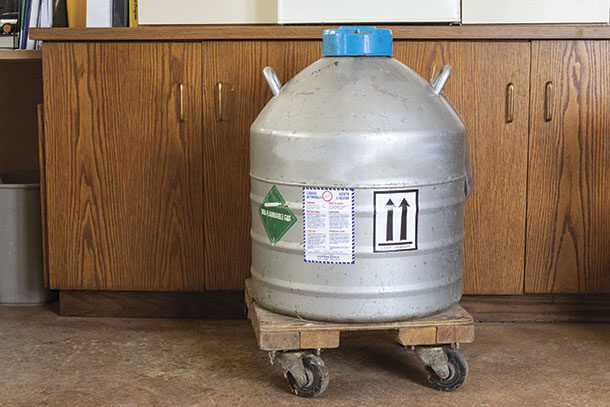When it comes to new breeding strategies in your herd, there is a lot to navigate. How does this impact replacement inventory? What are the trade-offs? Novel strategies usually have an extra cost – right? Luckily, beef-on-dairy crossbreeding is a win-win. Not only is a beef-on-dairy calf worth more at market than a straight dairy calf but targeting sexed dairy semen use on your best females and using beef on your lower-merit females accelerates genetic progress in your herd.
Adoption of the beef-on-dairy breeding strategy has exploded over the past few years. According to the National Association of Animal Breeders (NAAB), the number of beef units sold into dairies has increased by almost 460,000 in the past year alone.
The beef supply chain has started to differentiate between good and not-so-good beef-on-dairy cattle, whether it is at the feedlot or on the rail at the packing plant. This means we can’t just use any old unit of beef semen found in the dark depths of the nitrogen tank. “Program cattle,” meaning beef-on-dairy crosses that are traceable in some way to known elite beef genetics and quality calf care, are fast becoming the norm in the supply chain. Many A.I. companies have specific sire lineups available to maximize terminal performance while still bringing fertility and calving ease to the table. Often, colored eartags are used to identify program calves, and the rainbow of colors points back to a common theme: ideal genetics.
However, what is right for one dairy herd, calf buyer or feedlot might not be right for another. How do we select the right beef breeds to maximize value in a certain system?
One size does not fit all
Looking at the current state of beef-on-dairy usage, a couple key players stand out. Angus, SimAngus, Limousin and Charolais have been some of the options at the forefront. Early in beef-on-dairy’s popularity, Limousins held the highest usage in 2019, though Angus have taken the top spot as of 2021, according to Select Sires’ sales data. For specific marketing streams, Wagyu have become an increasingly popular option.
Each breed brings something to the table. Continental breeds like Limousin and Charolais offer growth and muscling, pairing well with the inherent quality provided by a dairy carcass. Angus has become the most commonly used breed, initially targeted for its calving ease and maternal traits. U.S. Meat Animal Research Center (MARC) data shows breed improvements over time to superior growth traits and carcass weights. Furthermore, “the majority of grids offered by packers today are very focused on Quality Grade and branded program acceptance. Quality Grade premiums at the packer have reached record levels in the past year with the Choice-Select price spread over 30 dollars per hundredweight and Prime similarly priced above Choice while Yield Grade 1 premiums have remained capped at 5 dollars per hundredweight. Angus genetics have been successful in bringing a high-quality carcass to the packer,” says Paul Dykstra of Certified Angus Beef. Likewise, SimAngus bulls have been used to bring a combination of red meat yield and marbling to the carcasses. Wagyu marketing streams have also been capitalizing on consumers' desire for taste and tenderness.
Influential factors
All these breeds can be used successfully in beef-on-dairy programs on a dairy. But, depending on several factors, they may have different levels of success – there is not one true "best" option. Let’s look at the different factors that can help direct you to the right beef breed for your production system.
Dairy herd breed
What is your breed base? If your herd is predominantly Jersey, it is important to note that prices on day-old beef-on-dairy calves tend to be significantly less than those out of Holsteins. If you are able to align with a market desiring a niche cross like Wagyu x Jersey or have a buyer strongly preferring a specific breed due to their downstream marketing, aligning to those needs may boost your return over a mixed strategy. A lesser considered yet creative option is full-beef embryos instead of beef-on-dairy. These calves have brought upward of $400 in some markets. As for Holsteins, Angus has proven to produce the heaviest cattle and heaviest carcasses on the rail, with fewer days to finish according to research published by Penn State. This is great for the beef supply chain, and the calving ease associated with this breed is great for the dairy producer as well.
Geography
Where are you located? You may notice a difference in breed preference among calf growers and feedlots across different regions of the U.S. Charolais crosses are popular in the Northwest, where there is significant feedlot preference for hardy, feed-efficient crosses produced by this breed. A common theme among feeders preferring Charolais influence is the Charolais crosses' performance and vigor in the yard.
Buyer wish list
By now, you should clearly see a trend appearing. At the end of the day, the value at market is driven by buyer demand. Get to know the market in your region. Where are the calves going? How are they marketed down the line to packers – cash basis or grid? If cattle sell on a grid, what does the grid reward – quality or yield? If you have a consistent buyer, producing the kind of beef-on-dairy crosses that fit their needs can create a more fruitful, longstanding relationship. Aligning with consistent buyers takes the guesswork out by collaborating with the beef supply chain to select the right breeds that address their needs. Of course, this leads to a new level of discussion beyond breed. As many in the beef value chain are learning, performance, whether in the feedlot or on the rail, varies within a breed. Many are working to identify the right profile of individual bull that best fits their system to select a desired sire lineup, regardless of breed.
At the end of the day, there is not one breed alone that is perfect for every single dairy – but there are certainly ways to pick the right breed and sires for yours.










